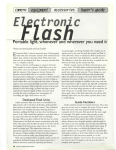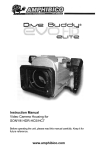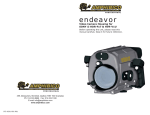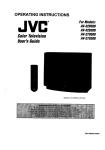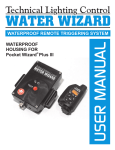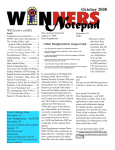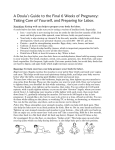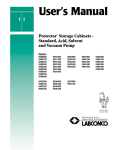Download WVDEOGRAPHER - Jack and Sue Drafahl
Transcript
SKIN DIVER MAGAZINE 1992 AMPHIBICA UNIVERSAL V-80 U/W HOUSING LSFOR WVDEOGRAPHER Amphibico's V-801 operates using a different concept in video nous ings—electronic controls. Because no mechanical controls touch the camera, you don't have to worry about damaging delicate camera controls or aligning the control knobs. There is also less chance of flooding. TEXT AND PHOTOGRAPHY BY JACK AND SUE DRAFAHL O ne of the drawbacks to housing camcorders is that each camera control has to align with a gland in the housing in order to utilize the camera's full capability. There is a chance of damaging delicate camera controls, as well as a potential for flooding, owing to the number of through-housing glands. Amphibico's answer to these problems comes in the form of a different concept of video housings—electronic controls. Using the remote control jack found on many of the newer cameras, Amphibico has created a housing that has no mechanical controls that touch the camera. The camera and housing are joined by a simple plug-in connector. Using this electronic control, the housing now be44 SKIN DIVER JANUARY 1992 comes as versatile as the camera itself. Speaking of the camera, the Sony CCD-V-801 offers new tools to the underwater videographer. With this Hi 8 camera the reproduction quality is excellent. Another plus is that you can put a time code on the original master cassette. This becomes useful when it comes time to edit as you can edit direct from the master. Usually you need to make a copy of the master with a time code for editing, consequently, this unique feature will save you one generation. Another feature of the Sony CCD-V-801 is the 10x zoom on the camera. This allows for maximum magnification in those close-up images. Enough said about the camera, let's talk about the housing that takes it to the depths of the ocean. AMPHIBICAM UNIVERSAL V-801 This compact white housing has a unique bayonet lens mount system, which includes a high quality wide angle adapter, optical dome port and extended lens hood. If you need to remove the lens assembly, pull slightly and turn it to the right. Once the assembly is removed, you can grease the O-ring or attach a different lens assembly. The front of the main aluminum body also has two smaller ports for external sound and an audible moisture alarm. The external sound mike is electrically attached to the camera and eliminates Above: The lens assembly is easy to remove—simply pull and turn it to the right. Right: The external mike is electrically attached and eliminates the sounds of the camera. Below: Video lights are easily mounted on the housing's handles. Atop the camera is an external monitor housing. the sounds of the camera operating inside the housing. The optional audible sound alarm is attached to a separate electronic system inside the housing and will detect the slightest amount of water. A standard moisture detector comes with the housing and displays a fast blinking red light through the plexiglass port on top of the housing. Two lightweight handles are bolted to the side of the housing. Each of these uses a single bolt and an interlocking slot to ensure a solid attachment to the housing. For shipping, these handles can be removed easily with an alien wrench, supplied with the housing. The tops of these handles also serve as platforms for mounting external video lights. Each handle has a very comfortable anatomical grip, allowing easy handling of the housing and access to the camera controls. In front of each of these handles you will find two camera controls. They are double O-ring sealed through the hous- ACCESSORIES Video Light PAC II $875 Video Light PAC I $595 Close-up Kit $349 Surface Umbilical Cable (100')...$315 Flat Port $218 Nikonos Mount $94 Audible Moisture Alarm $92 Nikonos Strobe Mount ...$39 ing walls and connect to a circuit board inside the top of the housing. Activation of any of these controls causes an electronic signal that goes through the circuit board and then through the remote cable, attached to the remote jack on the camera. Depressing the top control near the right handle activates the camera. A red light will blink once through the plexiglass port on the top of the housing. Depressing the lever a second time starts the camera recording. The red light will continuously blink as long as the camera is in the record function. Depressing the lever or pulling it back will instantly change from record to standby. If you leave the camera in standby for more than one minute, it will turn off to conserve battery power. To turn it back on, simply depress the lever twice. The bottom right control allows manual focus. Pressing down on this control focuses the lens closer, while lifting up on it allows focusing on more distant subjects. This control is electronically disconnected KEY FEATURES • Full electronic control of camera • Compact aluminum housing • Bayonet mount lens system • High quality optics and ports • Moisture detector • External sound recording • Quick disconnect handles • Both manual and autofocus • Accepts four types of Sony camcorders: CCD-V-801 Hi Band, CCD-V-101 Hi Band, CCD-F-77 and CCD-F-55 when the camera is in autofocus. The top lever on the left side of the housing controls the zoom function. Pressing forward on the control zooms the lens to telephoto focal lengths, while pulling back on it turns the lens to wide angle focal lengths. A special locking device can be attached to the control so you can zoom the lens (Continued on next page) SKIN DIVER JANUARY 1992 45 AMPHIBICAM into macro function. When the camera is in the macro position, autofocus is automatically disabled. The bottom control on the left side performs several tasks. Pressing down allows you to switch from autofocus to manual and back again. In the manual position, you use the bottom control on the right side of the housing. Pushing the lever up allows you to select white balance for indoor and outdoor situations. The housing's back plate is attached securely with two stainless steel catch and strike latches. The main housing has a sloped O-ring surface, so maximum contact is possible. A variable focus magnifier is mounted to the back plate, allowing full frame viewing. The bottom of the housing has two sizes of tripod sockets, slots for weights and four small rubber legs so you can set the housing down without damaging the surface you set it on. INSTALLING THE CAMERA Camera preparation requires removing the lens hood, cover, magnifier and the camera's accessory shoe. A small clamp furnished by Amphibico is attached to the zoom macro, so the camera can be continuously zoomed from telephoto to macro without making any changes. Attach the external sound jack to the front of the camera and the remote jack to the rear. A large metal plate is then attached to the base of the camera. The camera and baseplate slide into a slot in the bottom of the housing. A small latch at the back of the camera plate keeps the camera in place. Electrical connection is tested by pressing the power lever on the right side of the housing. If you have a red light, you are ready to close the back of the housing. After placing the back in the correct position, you close both clamps at the same time. LENS OPTIONS Amphibico's V-801 housing comes with three possible lens options and two types of lens ports. The 120 and 100 degree three element lenses are for wide angle subjects and are used with the high resolution dome port. The .6x close-up lens should be used for subjects only a few feet away and includes the extended flat port with a +1, +2, +3 diopter set. We've Trained Divers Since 1969 .TEXAS Our Training Includes: • Air Diving • Mixed Gas Diving • Bell Diving • Chamber Operations • Underwater Welding • Underwater Burning • Nuclear Diving • Inspection Diver CALL TODAY FOR INFORMATION 1 -800-321 -0298 or 713-530-0202 (Collect) 10840 Rockley Rd. Houston, Tx. 77099 46 SKIN DIVER JANUARY 1992 UMBILICAL CONNECTIONS If you want to use the camera on an umbilical cable, you can order cables up to 1,000 feet long. This cable is attached to the housing via a bulkhead connector.(Keep in mind that the housing is depth rated to 350 feet.) PRACTICAL APPLICATIONS OF AMPHIBICAM V-801 For quick and easy use we found you could set the camera on autofocus, zoom to wide angle and then press to record. When you find fish you can't get close to, you can zoom to telephoto and set the controls to autofocus. If you are swimming through kelp or soft coral, we found that turning the autofocus off and using manual worked much better. If you want to pan from a diver to a close-up in one shot, you leave the autofocus on with the lens in a wide angle position. As you pan from a diver to a close-up, slowly zoom from wide angle to macro. When the lens goes into macro, the autofocus turns off, so the focus can't drift. For general use we found that the record/standby switch on the right and the zoom control on the left were the most accessible and the most commonly used controls. CONCLUSIONS A key feature of the V-801 housing is its electronic camera controls. Because no mechanical controls touch the camera, you don't have to worry about heavy 'hands damaging the camera or aligning the control knobs. The housing is com- fortable to hold and the viewfinder is easy to see through. The quality of the Sony CCD Hi 8 camera, combined with the professional look and feel of the housing, create an excellent tool for the underwater videographer. Amphibico has recently introduced an external monitor housing that can be installed in minutes on the top of any Amphibico housing. The use of a monitor greatly assists in achieving correct light balance, subject bracketing and fine focus. For further information about the Amphibicam V-801 contact Amphibico Inc., 9563 Cote de Liesse, Dorval, Quebec, Canada H9P1A3; (514)636-9910. w> ADVANCED DIVING (Continued from Page 18) than normal •Questioning if you ate some bad food at the last meal • Having trouble assembling your usual equipment If any of these symptoms occur, then it is time to catch yourself and ask "What's really going on here?" You are clearly not in sync with the pre-dive activities. Sometimes all it takes is being aware that you are feeling rushed or uncomfortable. This allows you to "take 10" and regroup. Figure out what is bugging you, change the situa- tion if possible or decide how to better cope with what you cannot change. If you brought some angry or unsettled feelings with you from home or work, mentally isolate those thoughts. Once you realize you are feeling rushed and crabby because your boss chewed you out at the end of the work day, it is easier to put those feelings aside and consciously replace them with positive thoughts about the pleasurable dive that is upcoming. Level with your dive buddy about the stress you are feeling. His/her comments and support may interject some humor and sympathy. Once tuned in to your anxiety, your buddy can be supportive—plus it may reduce his or her stress, especially if he/she has been on the receiving end of your cutting comments. Talking out problems with a sympathetic friend often puts the issue in clearer perspective. Dealing with self-stress begins with your own intellectual recognition that things aren't right. It can be nipped in the bud by taking actions to change the irritant or answer the doubt. When diving with a group, peer pressure can cause stress. The competition to get in the water first or catch the biggest lobster or dive deeper or longer or make it through the biggest surf can be intimidating. You can play the game or you can be an individual. Sometimes standing up for how you want to dive, especially when it conflicts with the group, is the mark of a 1992 GREAT NIKONOS SHOOTOUT BONAIRE June 20-27 The Nikonos Shootout in Bonaire is the dive vacation you've always wanted. Discover a myriad of marine life along the spectacular reefs of one of the world's premier dive sites. You'll be treated to free underwater photo courses, ecological seminars and dive workshops taught by top pros at a first-class dive resort. And participate in an extraordinary underwater photo competition exclusively for amateurs where even beginners can win great prizes. Make this the one! Come join the fun! For Shootout registration and reservations, call: 800-272-9122. Participating Resorts: Flamingo Beach Sand Dollar Captain Don's Habitat Nikon \\fetaketheworkTs greatest pictures.' Shoo, circle #247 on Reader Service Card leader who sets the standard and earns the respect of his/her peers. Enlist your buddy as an ally in stating what you're going to do when there is pressure to exceed your personal limits. Sometimes the other parts of your life are admittedly stressful. Family, job and money worries can make you want to get away from it all and going diving is a temporary escape. That's fine—if you can compartmentalize the problems, thus leaving a window for some untroubled time. If you ignore the pre-dive mental and physical stress messages and enter the water, then the in-water multiplier effect begins. The liquid environment and dive gear compound the situation and a domino-like effect can begin. IN-WATER STRESS SIGNALS Following are some common signals that a scuba diver is experiencing stress: • Hard breathing or feeling as if you aren't getting enough oxygen •Feeling as if your stomach is tied in a knot •Pounding heartbeat •Cramps for no apparent reason •Trouble clearing your ears (if this is atypical) •Wetsuit constriction coming on during the dive •Darting eyes making it hard to focus on the intended activity or failure to




